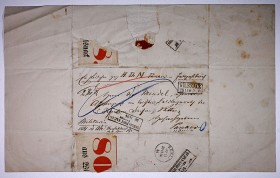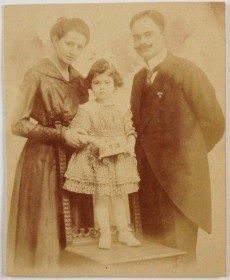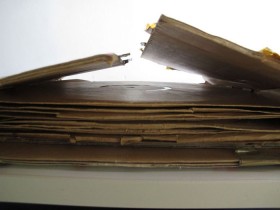
Letter accompanying the award certificate for the Order of the Red Eagle, Fourth Class, bestowed upon Emmanuel Mendel © Jewish Museum Berlin, gift of Wolfang Schönpflug, photo: Ulrike Neuwirth
A huge number of objects enter the collection of the Jewish Museum Berlin every year. Each must be inventoried and studied. Many of these items have a long history, often having circled the globe. Having survived flights, emigration and decades of storage, some documents are in such bad shape, they cannot be used without further damaging them. As paper conservators, our task is to at least conserve, if not restore, these objects, so that they can again be handled without exposing them to additional wear and tear.
→ continue reading
Shortly after the opening of our temporary exhibition “Snip it!”, the Jewish Museum received as a bequest the estate of Fritz Wachsner (1886 – 1942). Included in this delivery was a bundle of letters so enormous that I didn’t have time, in creating an inventory, to delve into each individual piece. But one letter caught my attention. “[…] Your assessment of the circumcision issue […]”, wrote Wachsner on 24. July 1919 to his – then very pregnant – wife Paula’s uncle Anselm Schmidt (1875 – 1925). I read on and suddenly found myself in the middle of a nearly one-hundred-year-old internal Jewish debate on circumcision.

Fritz Wachsner with his wife Paula and their first-born child, Charlotte, studio portrait, ca. 1916 © Jewish Museum Berlin, photo: Jörg Waßmer, Gift of Marianne Meyerhoff
At the time, Fritz Wachsner was 33-year-old teacher in the town of Buckow in Brandenburg. In the five-page letter he clarifies the reasons for his hostile stance towards the Bris. He was an assimilated German Jew and belonged to a Reform Jewish congregation. As he explains to his uncle, he was “raised fairly orthodox” but, in the course of his university studies in Berlin and Jena as well as at the Academy for the Study of Judaism in Berlin, he learned “to know and appreciate the spirit of Judaism freed from every non-German embellishment”. He became persuaded that the religion should evolve continually and be “modernized and improved”. Wachsner’s maxim was: “Become German, outside as well as inside the religious community”, the overtones of which are especially → continue reading
There are films slumbering in an archive somewhere, waiting to be discovered. And there are films that have sunk into oblivion but then suddenly pop up again, in the form of a soundtrack.

The schellac records, as found © Jewish Museum Berlin, Photo: Regina Wellen
Recently, when stock was being moved to another depot, our colleague Regina Wellen looked over the collection of 78rpm schellac records with a view to devising a new way of storing them. She thereby came across eleven not yet inventoried records, much larger than the usual sort and with a label suggestive of some other purpose than easy listening on the home gramophone. Luckily for us, Regina was quickly able to establish that these were examples of the sound-on-disc recordings played in cinemas as an accompaniment to screenings of otherwise silent films—synchronously, thanks to the built-in start signal. One of the twenty numbered boxes on each label used to be checked after each screening, so as to ensure that a worn-out record would be replaced in good time. After Regina had dry-cleaned the records and prepared → continue reading


